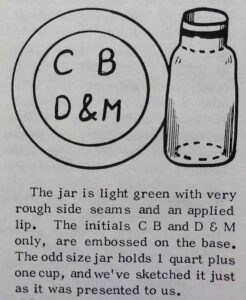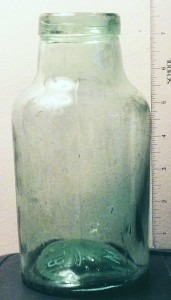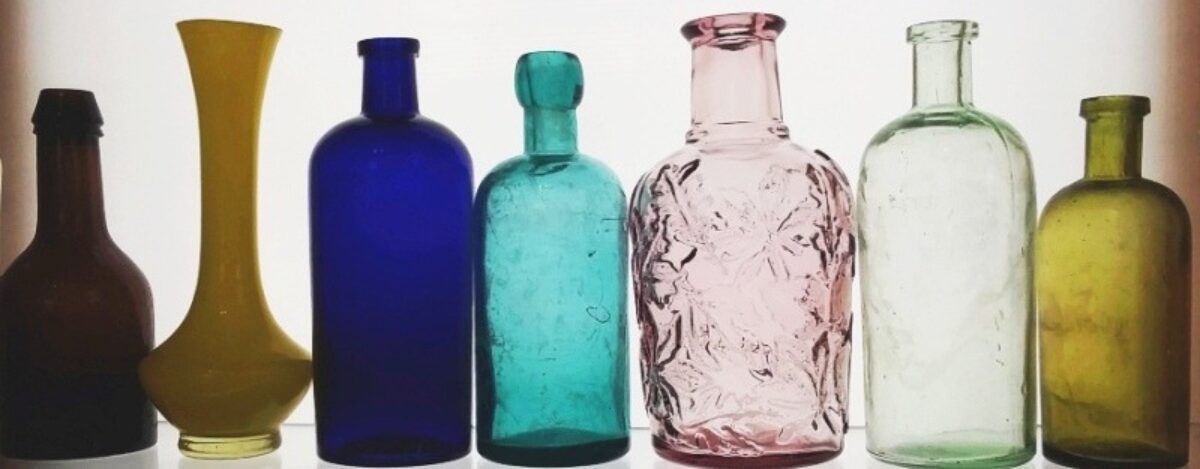C B B, C B K, C B M marks on glass bottles: These marks have been attributed to Kilner Bros Glass Company, Thornhill-Lees, West Yorkshire, England (United Kingdom). They are seen on the bases of handmade (mouth-blown) light green cylindrical food jars/bottles made in England during the late Victorian era. With applied lips, they are usually of rather heavy, thick glass, and often contain bubbles, in-the-making flaws, and show crudeness typical of bottles of that era.
They are of a type of container generally listed in some earlier glass factory catalogs as a “Chow-chow” or “English Pickle” bottle. Chow-chow is a type of pickled relish, very popular in the Victorian era and still popular today, especially in the southern states of the US. The term Chow-chow covers a wide range of recipes, usually consisting of a combination of chopped green tomato, cabbage, onion, green pepper, along with vinegar, sugar, salt and other spices. Judging from the original labels still affixed to some examples, these jars were used to contain a variety of products besides Chow-chow, including cucumber pickles, olives and other types of preserved foods.
Judging by their general appearance, these jars appear to date primarily from the 1870s (possibly as early as the late 1860s?) into the early 1900s or 1910s. The letters on the base are arranged in a triangular configuration, with the third letter usually centered underneath the first two letters. There may or may not be a raised dot or circular protuberance (called a mamelon) in the center of the base. On some examples a mold number, such as “1735” or “656”, is also embossed on the base along with the three letters.


The C. B. M. jars were attributed to Kilner Bros Glass Company/Kilner Bros, Ltd, Thornhill-Lees, West Yorkshire, England (c.1857-1937) by fruit jar researcher and author Alice Creswick (The Fruit Jar Works, 1995). She attributed the jars to Kilner because they appear virtually identical to a type embossed “KILNER BROS / MAKERS / LONDON” on the lower front and bearing the base marking “C B K 2667”. The closure illustrated in her reference book (a glass stopper) was the same shape as those found on Kilner-marked jars, and the stoppers are lettered “J. Kilner & Sons Wakefield” or “KBT”.
The markings “C B / M” or “C B / B” on the bottom do not intrinsically make sense to me: so why not “K B T”, “K B Ltd” or “J K & S” on these jars if they were made by Kilner? (See those Kilner-related marks on Page Three.)
For some time I had wondered if these jars could have been made by some other glass factory (such as Charles Borron & Company, 1866-c.1898 – see “C B & Co” mark entry on page two ), however, since the base of the “Kilner Bros / Makers / London” jar, as illustrated in the line drawing in Creswick’s book on page 94, is allegedly lettered “C B K”, that serves to show there is likely a connection- thus Kilner presumably made the jars marked solely with C B M (and other combinations) on the base (but, see my comments on Crosse & Blackwell, below).
These jars are listed in “The Fruit Jar Works” (Alice Creswick) and the accompanying volumes – the “Red Book” fruit jar price guides for collectors. The jars marked ” C B M” are cataloged as #1400, the variant base-marked “C B B” is listed as jar #1401, and the “C B K” variant as jar #1402. These jars were presumably not intended strictly as “fruit jars” although I am sure many were used (or reused) for that purpose.
ADVERTISEMENT
Another thought: The “C B” markings may stand for Crosse & Blackwell, a well-known and long-time producer/distributor of food products in England (including pickles and chow-chow), although currently I don’t know if there is sufficient evidence to confirm this possibility. If “C” and “B” stands for “Crosse & Blackwell”, what do the letters “M”, “K” or “B” stand for? A glass manufacturer? A city name? And, if these were made for Crosse & Blackwell, can we really be sure that Kilner made all of them? C&B contracted a number of different glass companies during that time period to make jars for them, and could have dictated what, if any, markings were used on the bases of the jars.
[Note- added 1/9/2025 – I recently became aware of another variation of this type of mark – “C B / D&M“, as shown in a drawing submitted to the Old Bottle Magazine by reader Bob Carter of Clayton, Ohio -shown in their April 1972 issue, page 50 (shown below). This lends credence to the theory that the “C B” stands for Crosse & Blackwell and the letter (or, in this case, letters) placed on the second line is the initial of a glass company. “D & M” is fairly well-known to have stood for Davey & Moore, a glass manufacturer in England during that time period. ]

If any British bottle collectors have more information or insight about marks on glass bottles in that area and who could shed more light on these jars, I would like to get some input from you! I want this page to be as accurate as possible! Thank you!



Click here to go to the Glass Bottle Marks pages (page 2).
Click here to go to my Home Page.
ADVERTISEMENT


Just found one marked CBK with a dot in the middle and the numbers 3853. Dug it up in our front yard. House dates to circa 1800 just outside of Phoenixville, Pa. Near Valley Forge.
Hi Benjamin and thank you for your post!
David
I have a light green bottle like the one above and it has C B on top and M on bottom and numbers 387 on bottom..can you tell me the approximate age of this bottle? THANKS!
My grandmother was an antique dealer in her younger years and collected many things. She gave me a jar I thought was beautiful that must be one of these! It is marked with C B K 1778. We are from Maine but she did her antiquing all over New England.
Hi Jill,
Thank you for your comment! Evidently there are quite a few different varieties of these jars out there. I suppose the “1778” is a mold identifying number. Take care,
David
Hi Jill, I have the same jar with same markings. Mine came from the wreck; City of Houston off the NC coast; sunk Oct 23 1878. Still had the peach seeds inside it.
Jerry, this is great information! I’ve assumed these jars date from sometime in the general time period of 1870s-1890s, but this kind of info certainly helps narrow down the time range when certain jars were made. Thank you very much for your post!
~David
I found a bottle underground in my backyard near the Missouri River. My house was built in 1889 and looks like one of the bottles you posted. It has a CBK 1775 in a triangular form underneath the bottle. Surprisingly enough I have found many other bottles while doing construction on my home over the last few years. Most of them are small this was the only large one I have found
Found a bottle identical to the CBM in picture above. Bottle found 1m underground in my back yard as I was digging new fence post holes. Bottle has CBK ON bottom. House was built in 1880 in Riverdale area of Toronto.
John, thanks for the post! Those bottles were probably exported around the world, so they might show up just about anywhere! Take care, David
We just found a piece of dark green sea glass that is inscribed with WALL & NORRIS, BRITAIN. Any clue to it’s origin. We found it on the NC coast.
I have just found a pickle jar … with C B above K below in a triangular with a series of dots in an arc heading anticlockwise from the base of the K. Found while diving in Swansea Channel NSW Australia. Old green glass
Hi Tony,
Thank you very much for your info!
~David
I have a bottle with the initials CBK in the same configuration as described but, it also has what appears to be a year. 1735 which of course would be too early to be from Kilner.
Carl, the “1735” on your bottle is a design or style number assigned by the glassmaker to that type of container. Many British-made bottles and jars, especially of the late 1800s and early/mid 20th century, are marked with three- or 4-digit numbers on the bottom which identified the bottle shape or style. Many glass companies in Britain evidently did this……these numbers would have been used in communications between the glass factory and their customers (invoices, letters, catalog listings, etc) and on their in-house inventory paperwork.
~David
Hello I too found a jar identical to the ones you have shown but mine says 9272.